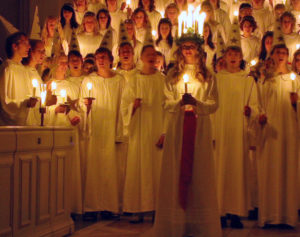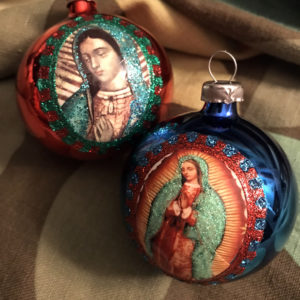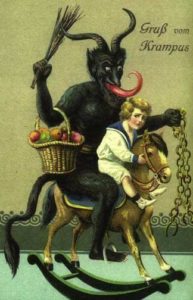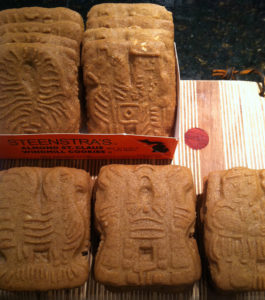The night walks with heavy steps around farm and cottage.
Around the earth, forsaken by the sun, shadows are lowering.
Then into our dark house she treads with lighted candles,
Sankta Lucia, Sankta Lucia.
The night is vast and mute. Now here reverberate
in all silent rooms a rustle as of wings.
See, on our threshold stands––whiteclad, lights in her hair––
Sankta Lucia, Sankta Lucia.
“The darkness will soon take flight from the valleys of earth.”
Thus she a wonderful word to us speaks.
The day shall again, reborn, rise from a rosy sky,
Sankta Lucia, Sankta Lucia.
It is St. Lucy’s Day: the Feast of Santa Lucia, a celebration that gets jumbled up between things Italian and Swedish for Lucia is sacred to both Italy and Sweden. Even the song that is sung throughout Sweden this night is Italian in origin, an old Neapolitan melody, transformed and rewritten for a place where, at this darkest time of the year, the night is vast.
There are processions tonight throughout Sweden celebrating Sankta Lucia: in churches, in schools, in city streets, on national television. Each will feature a Lucia, donning a wreath of glowing candles upon her head, with scores of her attendants: boys and girls dressed in white, each bearing a candle, and then the Star Boys, each carrying stars on poles and donning tall white conical caps. It is one of the most beautiful sights of these ever-darkening nights on the approach to the solstice.
Our local Sankta Lucia festival was in November: quite early, but that’s when the church hall was available, so that’s when the SWEA ladies––the Swedish Womens Education Association––held their celebration. We were there with a pop up shop of advent calendars and candles and artisan goods from Sweden. All day long, the women spoke to me in sentences that began in English and evolved to Swedish before they ended. I did not understand much. But I did understand Tack (Thank you) and glögg and lussekatter.
In Italy, lucky children awoke this morning to find tiny presents tied to their shoelaces. That’s if they left hay and carrots in their shoes before they went to bed, for Santa Lucia’s donkey. Santa Lucia follows St. Nicholas as the next of the Midwinter gift bearers. Lucia calls down the light at this dark time of year perhaps more strongly than any other saint or gift bearer. Her very name in Italian, Lucia, is rooted in the word luce, which translates to light. She is a patron saint of the blind and the visually challenged, and also of writers like me, and scholars, teachers, and librarians.
Seth’s great aunt was named Lucy. Her father, an immigrant to Maine from Italy, lost his sight in an accident on the railway where he worked. This was in the early 1900s. Aunt Lucy was born soon after the accident, so naturally, her parents named her for her father’s new protector. “But I was no saint,” she would confide to us.
We will think of Aunt Lucy and we will have our coffee and lussekatter and we will have the Santa Lucia song in our heads and on our lips all day and all night, in Swedish and in Italian. All of these things bearing light––luce––to the Midwinter darkness.
COME SEE US!
“Yule” love what we have at each of these markets! They’re the last of our local pop up shops before the holidays.
Undiscovered: An Inclusive Arts Festival
Saturday December 14 from 10 AM to 4 PM (but we have to pack up by 3!)
at Palm Beach Habilitation Center
4522 South Congress Avenue in Lake Worth
We’re so excited to take part in this inaugural arts fair at the Hab Center, which does such wonderful work helping folks with disabilities become more independent through training and employment. There are art projects that EVERYONE can participate in, and there’s a pop up market; we’ll be there with lots of great artisan goods from our catalog.
Holiday Night Market
Saturday December 14 from 4 to 8 PM
at Social House
512 Lucerne Avenue in Downtown Lake Worth
It’s always a special night at Social House. We’ll be showing our Christmas artisan goods and Shaker teas (and my mom’s famous candy wreaths). One of our favorite markets at one of our favorite places!
Midwinter Makers Marketplace
Sunday December 15 from 10 AM to 4 PM
at Florida Atlantic University
777 Glades Road in Boca Raton
It’s full swing yuletide and we’ll be showing our handmade artisan Christmas ornaments and decorations from Germany, Sweden, and Mexico and our full line of Shaker herbs & teas and more (like my mom’s famous candy wreaths). Plus there’s live music almost all day: Ella Herrera from 10 to 1 and Rio Peterson from 1 to 4. Look for the blue & white MAKERS MARKETPLACE signs on FAU campus roads.
Revelry Sip & Shop
Sunday December 15 from 1 to 6 PM
at Revelry Lake Worth
17 South J Street in Downtown Lake Worth
Find us in the courtyard with our handmade Christmas artisan goods and Shaker herbal teas and more. They’re serving bottomless mimosas!



